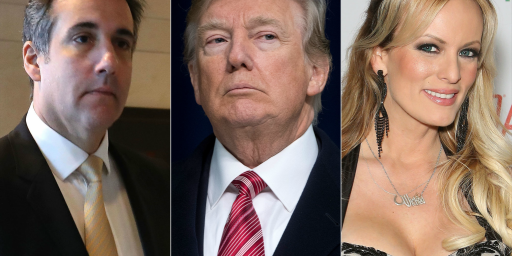A Spotify for News
Publishers and consumers want very different business models.

Writing at something called Fortune Crypto, Jeff John Roberts urges, “Paywalls are here to stay, but they’re closing off the internet. Crypto can fix that.”
The setup is familiar:
It wasn’t so long ago that the web was like a giant bazaar. You could return again and again to the digital version of your favorite stalls or explore what any random site had to offer. A lot of the content was crap—and still is—but the point is that it was open to all to see.
Today, the web is more like a crowded city with checkpoints on every block. You might be able to peer into a few store windows, or even be allowed to take a quick stroll, but it won’t be long until someone asks you to identify yourself and buy a monthly pass to stick around. In practical terms, this means it’s become harder to read about everything from major news events to a sports columnist’s clever take on last night’s game.
Thankfully, the transition is reasonable:
This isn’t a bad thing. After years of giving away valuable content for free—and later hoping Facebook or Google would share a few crumbs in advertising dollars—web publishers finally gained the confidence to ask readers to pay for their labor. And that in turn has provided a revenue stream that directly funds quality journalism.
The problem is that readers are getting cut off from more and more of the web. Even as more people are willing to pay for their favorite websites, no one can be expected to shell out in response to the dozens or even hundreds of paywalls they encounter over the course of a year. Worse, many digital publishers are acting like record-of-the-month clubs of the 1980s—roping users into subscription models where re-signing feels like a hostage negotiation.
Exactly. Indeed, it’s worse than that the typical trick is to make it easy to sign up at a low introductory rate and then hope you’ll forget to cancel. Or making it much harder to quit than to join in the first place.
The upshot is that websites are cutting off a growing number of readers who might pay a small amount to read an article, but don’t want to engage with aggressive subscription tactics or who may simply lack a credit card in the first place. The result is that both sides lose: Publishers are leaving money on the table while casual web surfers turn to free websites that are often cesspools of viral crap.
Again, this isn’t a new complaint. Not surprisingly, given the venue, blockchain is the proferred solution.
This is not a new problem. The mixed blessing of paywalls has been debated since at least 2007 when the New York Times deployed and then scrapped its earliest version, TimesSelect. The difference today is that technology has taken a giant leap forward, offering new tools—based around blockchains—that could make the web feel like the open, freewheeling place it used to be while also letting publishers make a living.
Julien Genestoux, a software engineer and self-described “fan of the open web,” worked at the popular blogging platform Medium in 2017 when it launched a paywall that allowed users to become “members” and access a variety of content by different authors.
“It was awakening to realize membership could have been the business model of the web the whole time,” says Genestoux, adding that the failure to build in a payment model was “the original sin of the web.”
He points out that the original designers of the web did envision a native payment tool. This is reflected in the existence of a browser error message describing a 402 error, which is analogous to the ubiquitous 404 error (“page not found”) but reads “payment not found.” But unlike the 404 error, the 402 message is still “reserved for future use.”
The existence of the 402 error page reveals that the web was supposed to have a native payment mechanism—one that let users pay for content without disclosing much in the way of personal information—but that for whatever reason it never got deployed.
I must confess to having somehow been unaware of the 402 page.
Genestoux has been hard at work trying to redeem this original sin with a service called Unlock. The site uses non-fungible tokens—unique digital tokens registered to a blockchain—as a way for readers to access content on different websites without the fuss of repeated credit card signups.
Unlock’s model relies on blockchain smart contracts to verify whether an NFT owner is in good standing and, if so, to grant them access to the participating publishers’ websites. Unlike a traditional website subscription, the membership can be transferred or sold. The publishers, meanwhile, can divvy up the revenue from NFT sales and resales by means of a smart contract or an offline arrangement.
In the future, Genestoux believes, web users will use NFTs to access bundles of content tailored to their interests—perhaps one that lets them read dozens of sports or entertainment sites. He adds that, along with convenience, the permissionless nature of NFT ownership reduces the potential for censorship. Specifically, controversial publishers like pornographers or radical political sites would be less at the mercy of payment providers like Stripe or Visa cutting them off.
Unlock isn’t alone. A company called Coil received $250 million from the crypto company Ripple to expand a service that lets readers pay $5 month to “stream” content from various websites. The service is free for publishers, who get paid a rate of 36 cents per hour for every user on their sites—a tiny sum, to be sure, but one that would becomes significant if multiplied by thousands or millions of users.
The latest company to attempt a crypto-based subscription model is the news and research site The Block, which encourages loyal readers to buy and stake tokens in exchange for full access to its content. A company called Civil attempted a similar model five years ago, and the project went down in flames—in part because readers, and even its own employees, found it confusing—but The Block is likely better positioned for success given its crypto-native reader base, and since overall knowledge of crypto and tokens has increased exponentially in recent years.
Yet despite this burst of activity to bridge crypto and media subscriptions, there is little evidence the idea is taking off with consumers. The trade publication The Defiant conducted a detailed survey of available services last year and concluded in a glum headline: “Micropayments for Content Refuse to Take Off and Crypto Isn’t Helping.”
That’s not surprising. What may be, though, is that crypto skepticism isn’t the main reason.
What’s the problem? While it might be tempting to blame the complexity of crypto or its dodgy reputation among many consumers, the biggest obstacle to adoption lies elsewhere—with publishers themselves.
Trevor Kaufman is the CEO of Piano, a company that made $80 million in revenue last year supplying paywall technology to hundreds of media companies, including the BBC, TechCrunch, and Fortune. He says Piano has experimented with micropayments and crypto for years, including a system where publishers could barter with one another to provide content access to one another’s employees.
But he discovered publishers wanted no part of this.
“Believe me when I tell you that there are no [Piano] customers around the world saying, ‘Hey, Trevor, it would be great if there was a micropayment option,'” said Kaufman.
He notes that there are non-crypto options that could make it easy for readers to purchase individual articles—such as PayPal wallets or Apple Pay in the Safari browser—but publishers have shown no interest in adopting them.
“There are ways to charge a little amount of money for short-term access, but it’s not a tech problem. The concern is that they’ll be cannibalizing sub revenue,” said Kaufman.
He explained that many publishers are finally enjoying a significant revenue stream from subscriptions, which not only put money in their pockets but provide a predictable cash flow against which they can borrow. Having finally developed a business model outside the vagaries of online advertising, they’re reluctant to meddle with it.
Indeed, some of the biggest paywall success stories are reluctant to even discuss micropayments. Both the New York Times and Dow Jones (publisher of the Wall Street Journal) politely declined to be interviewed about the topic.
This reticence is understandable given that publishers are emerging from a brutal two decades in which the internet destroyed their print-based business model, and Facebook and Google sucked up most of the advertising dollars they used to earn. But it’s hard to see how the current landscape of paywall silos, which sees a third of readers cancel their subscriptions within 24 hours, is sustainable.
I can understand why publishers would be leery. And, frankly, so should consumers. Even leaving aside crypto and going with something like PayPal or Apple Pay, it would be really challenging to keep up with the costs incurred on a cafeteria-style system. It would be easy to rack up really, really exorbitant charges given how much screen time most of us spend. And that’s assuming the system is on the up-and-up: what’s to prevent unscrupulous sites from charging considerably more than they advertised when the click was made?
“Consumers want a Spotify model,” Kaufman acknowledges—even if publishers don’t want to supply one.
It’s worth noting that other industries, notably the music and TV giants, bitterly fought against streaming services that offered up new types of content bundles but, in time, came to appreciate the value of services like Spotify or YouTube TV. It feels inevitable that web publishers will one day come around to a system that makes it easy for readers to pay for their stories across different sites, using crypto—or maybe something else.
In the meantime, Kaufman predicts that NFTs and other types of crypto payment probably won’t catch on for the foreseeable future, but that he remains open to it.
“Figuring out business models for content on the internet is one of the most important societal challenges we have,” he added, “so the more innovation the better.”
So, here’s the thing: I, too, want a “Spotify model.” That is not at all the same thing as micropayments. Bundled models like Spotify’s are an all-you-can-eat buffet; micropayments are a cafeteria.
I could envision variations that make sense for news. There could be a premium tier ($50/month?) that allowed ad-free access to all of the participating newspapers, magazines, and whatnot and an ad-supported tier at a lesser price (say, $25/month). Or something like a cellular data plan, where you could have unlimited visits for $70 per month and throttled plans at $50 and $25 that allowed much less consumption before being charged for going over the monthly limit.
The advantages of this system for consumers is obvious. Universal access, even to publications one might visit only one or two times a year. Predictable pricing. A single login. Maybe an ad-free experience. There’s really no downside unless you’re such a modest consumer of web content that what’s currently free is sufficient for your needs; presumably, there would be no free (at least, without ads) content under the new model.
There are both obvious advantages and disadvantages for publishers. The deadweight loss of people like me leaving your site in disgust who would happily have contributed to your revenue stream. Increased readership. Not having to pay to maintain a paywall infrastructure. But also less predictable—which, aside from revenue could also incentivize clickbait content and disincentivize investing in longform investigative reporting.
I can see where the likes of NYT, WSJ, the New Yorker, and other premium outlets would balk at participating. But, as noted, music companies and artists resisted, too. Even the Beatles are available on streaming services now.






First, blockchain pimping is as usual complete bollocks. A solution in search of a problem (that it is not structurally less efficient to resolve).
Second, when you say consumers, I think you actually mean “that narrow set of consumers seeking a wide reading” which probably also heavily overlaps with subscribers but not entirely. The publications lack of desire to self-commodify (again) given the economics of being a commodity producer are utter rubbish…. well.
I would be rather dubious that there is an actual increased readership on a sustained net basis for the top tier publications. 2nd/3rd tier prehaps but then probably the subscription is not that attractive for the consumer.
Started to read that article but quickly determined that it was plowing old ground with a new plow, crypto, and saw no reason to continue. As we’ve discussed here at OTB, there are several ways to resolve this issue but none have taken hold. Even if there were a micropayments system, if it still required me to log on to the individual website, I wouldn’t use it. So a single log on, transparent micropayment system, yeah sign me up, but it needs to be comprehensive and include the major publishing sources, otherwise it is of little use.
While a “Spotify” for news would be nice, if I were a publisher, particularly of a small or local journal, I’d be wary of a Spotify model payment system for reimbursement.
I’ve found a couple of ways to get around paywalls if I really want to, using Reader View or toggle off javascript.
Both typically eliminate images and allow only HTML ads, but they do let you read the text. Mostly, if it is a news item behind the paywall, some other source will cover it or report on the coverage. If the paywalled item is opinion or analysis ¯\_(ツ)_/¯
I’ll just point out that the “Spotify model for news” exists in Apple News, but the biggest publishers aren’t interested, as it removes their direct access to the reader.
People may want the Spotify model, publishers don’t. And while it’s convenient, it’s arguable if Spotify is a good thing for music, especially niche music.
@Kevin McKenzie: Publishers don’t, and I suspect writers and other creators don’t either. In Spotify superstars negotiate special, lucrative contracts while the rest get peanuts. I’ve heard complaints from musicians that many people here would recognize, who make a good living with sold out live shows and have for years, about earning only hundreds or perhaps a couple of thousand dollars a year from Spotify.
Putting that model on newspapers would mean the small local papers would lose their last revenue stream.
Seeing how blockchain is proposed as a solution for so many diverse problems, it’s beginning to feel like snake oil rather than cutting edge tech.
It also has to be added that music is fundamentally different from news, in that there’s already 80 years of recorded music, and compulsory licensing. Whereas news, by definition, has to be produced daily. So the economics aren’t the same.
@Kathy: not feels like, is. Blockchain is a solution in search of a problem. It doesn’t work well for anything in particular, outside of criminal activity, so it’s proposed as the solution for everything.
@MarkedMan:
Spotify and other streaming services are a poor deal for most musicians. Typically a musician will make more money selling one track on iTunes or similar than they will from dozens of streams.
Streaming is good for discovering new performers, but if you like them, buy their music and if you can do so via their website, that is the best way. Second best is the CD from a locally owned record shop, then your supporting two important pieces of the music community.
@Kathy: Over the past ten years or so, I’ve had blockchain pitched to me at tech conferences, from IBM reps as part of much larger projects, and even medical device trade shows. I ask everyone the same question: what problem is solved by blockchain that can’t be solved just as well or better without? I literally have not gotten a single coherent answer to that. Every couple of years I go searching to see if anything has changed and nothing has. The most recent time was just a few months ago and the latest “killer app” appears to be using crypto as currency within video games. Needless to say, video game manufactures figured out game currency decades ago and have been monetizing it without crypto just fine.
Don’t get me wrong. I wouldn’t be surprised if it eventually proved useful for something. That’s why I keep checking. But so far, it’s just been hype.
@Sleeping Dog: Even though I have an Apple Music subscription, when I find a song that I really like, I buy it from iTunes. It helps the artist far more than streaming it but I have to admit that the main benefit is that when I go to my “recent purchases” playlist, every track is a killer.
I’ve read finance blockchain pitches which are like why have 30 years of audited P&Ls and Balance Sheets when you can have access to every single transaction a company has made in the same amount of time? Yeah, I wonder about that.
Even more confusing is Urbit, which seems to be like the internet before web browsers. Saw this on twitter: “An Urbit guy wakes up in dimly lit warehouse. In front of him is a sheet of simple yes/no questions about Urbit (“Do you need a special computer to use Urbit?” “Can I use Urbit to browse the web?”). I’m sitting across from him with a car battery all rigged up and ready to go.”
@Lounsbury:
Indeed! (And somebody put a mark up on the wall somewhere–Lounsbury and a “lefty” agree on something.) As I have noted in the past about paywalled stuff, I rarely find a situation where going to Yahoo with the title of the article won’t either yield the article from the paywall source–sans paywall–the item from another source (gasp~!!!!! You mean there’s more than one place that prints news? WHO KNEW???).
I expect that this is another one of those, “if we could only buy the content we want on TV without having to subscribe to cable” things, except with this one being a plea for cable service. Hmmm…
@Kathy: Not beginning. Has been clearly snake oil since approximately 7 yrs.
@Kevin McKenzie: One should be fair as “work well” is somewhat black and white… one can say there is yet to be a use case where Blockchain is more efficient on a cost-time-resources basis than existiing solutions, and by structure tends to be slower and more resource inefficient.
Of course if one is not settlement time nor cost motivated for a solution (as in money laundering), it has a market proven use case. Regrettably for non-criminal blockhain promoters, all the use cases that meet that sort of criteria are essentially criminal use cases.
@Sleeping Dog: I could reasonably hypothesize that there is for non-trivial market segment of consumers additive market brought by Spotify, perhaps partial off-set. I think of myself, who ceased to be a music buyer decades ago and prior to deciding to try Spotify – and voila, someone who’d never buy more CDs (nor tracks really) is a revenue stream. That is probably a significant potential (of course market data may show not off-setting lost sales from stable streams).
But I do not think that News Consumers have generally a market segment of significant size like this. The market profile of the OP is a narrow one…
So for probably almost all writing cases, there’s not even the speculative gain case to be made unlike music (although again while I see my case, I can well guess that’s not off-setting loss side of equation).
In the time of AM radio music, musicicans and artists got paid via a statistical mechanism: Radio stations would buy licenses (probably from both ASCAP and BMI) and these licenses required them to report which songs they played. ASCAP and BMI would look at all the stations’ ratings and then divvy out the collected money according to who was getting the most airplay. After taking a cut.
We could do this with the internet. Is it a good model? I don’t know, but I think I’d like it better than what we’re doing now.
Need to keep crypto around so people can pay off those IT ransom demands. Not sure it has any other real purpose.
Steve
@MarkedMan:
Who knows. If Putin had equipped his army with blockchain, they’d be taking over Vilnius by now 😛
I live in an area where McClatchy controls many of the major newspapers over 3 states. It used to be you could just open the link in a Private/Incognito window but that stopped a few months back. Then there are the articles that are totally behind the paywall like High School sports, dining reviews, political endorsements (= why?) and in depth articles. Meanwhile we have several minor newspapers whose purpose is to print legal notices with some news filler. I’m more likely to go to a TV station for locally significant stories.